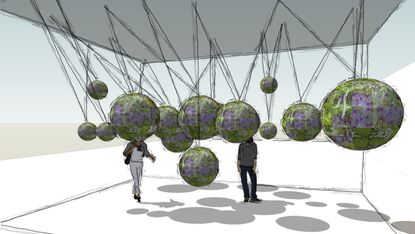Horticultured: Richard Miers's top garden tips
The designer takes a break from exhibiting at the House & Garden Festival to give his advice for creating the perfect green space

If summer has got you feeling green-fingered, take some inspiration from top garden designer Richard Miers. Known for his contemporary and geometric style, he has created outdoor spaces everywhere from bijou London pads to grand country manors.
His latest project can be discovered at the House & Garden Festival, where he has partnered with Quintessentially Travel to create a bespoke installation for the occasion. Taking the luxury travel concierge as his muse, the garden is inspired by journeys across the world, expressed through hanging 'globes' of flowers. On Friday 23 June, he will also be leading a talk at the festival, giving an insight into the thinking behind some of his favourite gardens.
To help you create your own grand garden design at home, Miers shares some of his top tips and considerations.
Subscribe to The Week
Escape your echo chamber. Get the facts behind the news, plus analysis from multiple perspectives.

Sign up for The Week's Free Newsletters
From our morning news briefing to a weekly Good News Newsletter, get the best of The Week delivered directly to your inbox.
From our morning news briefing to a weekly Good News Newsletter, get the best of The Week delivered directly to your inbox.
1. Hierarchy
Most, if not all, gardens are connected to a house. The house comes first, and the garden must connect to the architecture and feel at one, not fight with it. Help it hold hands with its surrounding landscape by having features such as an intense garden near the house that slowly blends into the fields or parkland beyond.
2. Scale and balance
Be bold and unafraid to make a big statement.
3. Proportion
Make sure what you create is in proportion to the other elements around it. For example, ensure the tree you plant won't swamp (or shade) a smaller scale herbaceous bed, or that the pergola you design is in proportion to the fountain sitting underneath.
4. Materials
Use the best natural materials you can afford, and those that will age well and get better with time. For example, oak will go grey and weathered and look better every year.
5. Water
Humans are 80 per cent water and the sight, sound and touch of water feels natural to us. Still water brings reflections of the sky down onto the ground and when the wind blows the ripples created can be mesmerising.
6. Repetition
Repeating certain patterns, shapes or colours will allow the eye to travel around a garden in a more relaxed and enjoyable way. Much like the melody of a song is picked up by the ear, the human eye searches for familiar patterns.
7. Contrast
The colour of flowers changes depending on what other colours they are next to, bringing them out of the ordinary. Additionally, the contrast between light and shade can be employed.
8. Space
The great British lawn is a good example, in which the intensity of a flower border is heightened by having the plain horizontal green of the lawn.
9. Texture
These can be matching or contrasting textures, and can be introduced through hard landscaping materials, such as a container or a wall, or in the foliage. Both work well, but think about how a big, shiny dark leaf will look against a little grey lavender leaf.
10. Colour
Clients often forget that green is a colour and the most peaceful and restful to us.
House & Garden Festival runs until 24 June at the Olympia, Hammersmith Road, London W14 8UX. Tickets from £16; houseandgardenfestival.com
Create an account with the same email registered to your subscription to unlock access.
Sign up for Today's Best Articles in your inbox
A free daily email with the biggest news stories of the day – and the best features from TheWeek.com
-
 Nigeria's worsening rate of maternal mortality
Nigeria's worsening rate of maternal mortalityUnder the radar Economic crisis is making hospitals unaffordable, with women increasingly not receiving the care they need
By Harriet Marsden, The Week UK Published
-
 'Elevating Earth Day into a national holiday is not radical — it's practical'
'Elevating Earth Day into a national holiday is not radical — it's practical'Instant Opinion Opinion, comment and editorials of the day
By Harold Maass, The Week US Published
-
 UAW scores historic win in South at VW plant
UAW scores historic win in South at VW plantSpeed Read Volkswagen workers in Tennessee have voted to join the United Auto Workers union
By Peter Weber, The Week US Published